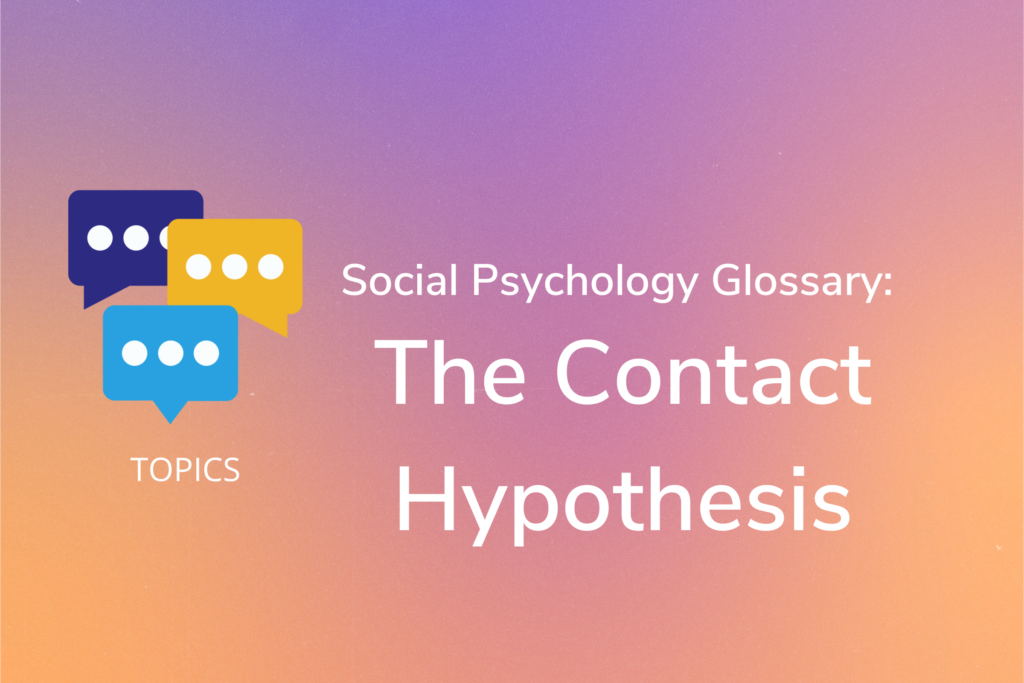Welcome to the Social Psychology Glossary!
In these posts, I will explain Social Psychology terms and theories and add some examples from research.
These terms and theories help social psychologists understand how people perceive others, interact with them, and make judgments about the social world and its members. These psychological processes can impact well-being and decision-making: being aware of their existence is a key factor that helps individuals and society to move towards gender diversity, gender equality, and equality in general.
Today we will explain what The Contact Hypothesis is.
Let’s start!
The Contact Hypothesis
In our last post of the Social Psychology Glossary, we discussed the definition of prejudice from a Social Psychological perspective. To sum up, prejudice is defined as an attitude composed of three components:
- A cognitive component, that includes irrational beliefs about a group
- An affective, emotional component, for example a feeling of dislike
- A behavioral component, that can comprise the inclination to harm or avoid a group
Prejudice maintains negative evaluations and status differences, and it is not something nice, leading scholars to wonder if and how it can be reduced. A solution to reduce prejudice was suggested in 1954. It is called The Contact Hypothesis (Allport, 1954), and scientific evidence collected over decades shows that this hypothesis works in reality.
The contact hypothesis focuses on prejudice between two social groups (for a better understanding of the psychological relevance of social categories, please check this first blogpost). The main assumption of this hypothesis is that contact between the members of the two social groups reduces prejudice, when four features of a contact situation are met:
- there is equal status between social groups in the contact situation
- the members of the groups share common goals
- there is cooperation between the two groups
- there is clear support from authorities, law, or custom
The assumptions of the contact hypothesis, however, have been slightly revised after this first formulation, in accordance with research findings. First, this hypothesis was originally formulated for inter-ethnic encounters, but research has shown that it can be extended to other social groups. Second, the findings have shown that the four conditions are not essential for prejudice reduction, but when the four conditions are met, the reduction in prejudice is typically stronger.
For example, let us imagine a study. Ideally (and simplistically ), if we want to test if contact between two social groups reduces prejudice, we can first measure prejudice before the contact happens. After this measurement, half of the participants can have contact with someone from the other social group, while the other half of the participants have contact with someone from their own social group. We then measure prejudice again. What do we expect? According to the contact hypothesis, we expect prejudice of participants who had contact with people from the other social group to be reduced, while prejudice of the other participants should be stable.
In these last posts we have explained some key elements of prejudice and the reduction of prejudice, which concludes this section of the glossary. In our next post, we will go in a different direction, focusing on a very interesting psychological mechanism that can influence many aspects of our lives: attribution.
Suggested readings
- Allport, G.W. (1954). The nature of prejudice. Reading, MA: AddisonWesley.
- Pettigrew TF, Tropp LR. 2006. A meta-analytic test of intergroup contact theory. J. Personal. Soc. Psychol. 90:751–83
- Wiley, J. (n.d.). Central Concepts in the Psychology of Diversity. 28.

Train the sponsor — Implementation of a new mentoring training (UK)
